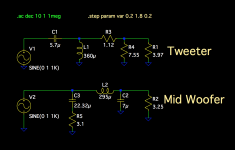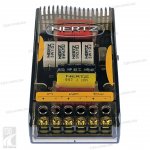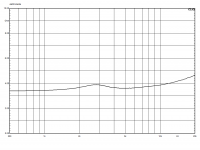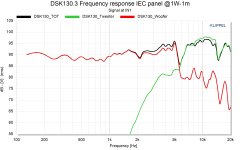Hello
I got two pairs of Hertz Dieci DSK 130.3 to install in my Renault Laguna II. Front and back doors allow only for 13cm speakers so I have to live with this.
After I installed them I must say I really like the mids that come out of this thing but the tweeters are killing me.
The crossover that comes with the set is total crap. A second order passive crossover only for the tweeter. The crossover box has both outputs for tweeter and mid/woofer but the mid/woofer connection is just a straight Wire from the input. The whole thing is a joke, using a ferrite core inductor and an electrolytic cap.
Now, the datasheet does state that the mid/woofer has a SPL rating of 93 and the tweeter of 94 but there's absolutely no attenuation/l-pad for the tweeter. As you can imagine, since the mid/woofer also reproduces the high frequency there's a highs nightmare in my car.
Now I took it upon myself to design a proper crossover for this thing, and I went for a second order Linkwitz-Riley alignment for both mid/woofers and tweeters.
I used the information presented here by Rod Elliott (great guy!):
Passive Crossover Network Design
I will use air-core inductors from Jantzen (cheap and good) and a mix of film caps. For the capacitors that are inline with the signal for the tweeter I am going with a polypropylene cap - Jantzen Cross Cap (cheap and I buy them from the same place where I get the inductors).
For the caps in the mids section I'll go with Wima polyester caps (real cheap).
I decided to make an L-pad for the tweeters so I can tame them a bit. I haven't decided on the values yet as even if it's just a 1dB difference between the units, either the mid/woofer Speaker is rated higher or the tweeter is rated lower. (yes, they don't say if the SPL is rated at 1W/1meter or 2.83V/1 meter. even so, doesn't matter as either way there's 1dB difference between them).
I did measure the tweeter and I found that it has a reasonably flat impedance. Wasn't expecting that but for sure it doesn't need a correction network.
The mid/woofer does need a Zobel network and it's calculated at about 3.1-3.3ohms/21-22uF. I did measure it's impedance and +3db frequency and the excel sheet spits out these values.
Since the original crossover has 3.5KHz crossing point I chose the same value for mine.
With the Zobel network in place the mid/woofer has an impedance of 3.25ohms at 3.5KHz and the tweeter has a nominal impedance of 3.97 at the same frequency (pretty accurate).
Now, with these values and the crossover frequency the components values came out like this:
For a 12dB/octave filter:
Tweeter: 5.73uF (5.6uF+0.1uF should do)
361uH (370uH inductor with one turn unwounded).
Mid/Woofer: 7uF(6.8uF+0.22uF should do)
295uH (300uH should do)
For the L-pad I will get 3 sets of simulated values.
For the nominal 1dB difference (with mid/woofer inductor losses accounted for):
Series resistance: 0.57ohms (0.56R available)
Parallel resistance: 18.74ohms (18R available)
For 2dB difference:
SR - 0.86R
PR - 11.04R
For 3dB difference:
SR - 1.12R
PR - 7.55R.
I will get the next standard values I find and make some tests and see how much I need to kill the highs.
Even with a separate amplifier there will be no need for higher than 5W rating resistors (for Lpad/Zobel).
The L-pad must be after the filter on the tweeter so there's no extra heat dissipated for no reason.
What I don't know for sure is...should the Zobel be before or after the filter on mid/woofer?
I attached the schematic for both filters and a picture of the stock filter.
Since on the front the mids are in doors and tweeters on the corner of the dash I need to make separate units for each driver. Hope I get to post some pictures with the finished product.
Hope Hertz answers my email where I asked them to provide graphs for impedance and frequency response of the drivers. Also to clarify if the stated SPL is at 1W/1meter or 2.83V/1meter.
I need to design the pcbs now.
I got two pairs of Hertz Dieci DSK 130.3 to install in my Renault Laguna II. Front and back doors allow only for 13cm speakers so I have to live with this.
After I installed them I must say I really like the mids that come out of this thing but the tweeters are killing me.
The crossover that comes with the set is total crap. A second order passive crossover only for the tweeter. The crossover box has both outputs for tweeter and mid/woofer but the mid/woofer connection is just a straight Wire from the input. The whole thing is a joke, using a ferrite core inductor and an electrolytic cap.
Now, the datasheet does state that the mid/woofer has a SPL rating of 93 and the tweeter of 94 but there's absolutely no attenuation/l-pad for the tweeter. As you can imagine, since the mid/woofer also reproduces the high frequency there's a highs nightmare in my car.
Now I took it upon myself to design a proper crossover for this thing, and I went for a second order Linkwitz-Riley alignment for both mid/woofers and tweeters.
I used the information presented here by Rod Elliott (great guy!):
Passive Crossover Network Design
I will use air-core inductors from Jantzen (cheap and good) and a mix of film caps. For the capacitors that are inline with the signal for the tweeter I am going with a polypropylene cap - Jantzen Cross Cap (cheap and I buy them from the same place where I get the inductors).
For the caps in the mids section I'll go with Wima polyester caps (real cheap).
I decided to make an L-pad for the tweeters so I can tame them a bit. I haven't decided on the values yet as even if it's just a 1dB difference between the units, either the mid/woofer Speaker is rated higher or the tweeter is rated lower. (yes, they don't say if the SPL is rated at 1W/1meter or 2.83V/1 meter. even so, doesn't matter as either way there's 1dB difference between them).
I did measure the tweeter and I found that it has a reasonably flat impedance. Wasn't expecting that but for sure it doesn't need a correction network.
The mid/woofer does need a Zobel network and it's calculated at about 3.1-3.3ohms/21-22uF. I did measure it's impedance and +3db frequency and the excel sheet spits out these values.
Since the original crossover has 3.5KHz crossing point I chose the same value for mine.
With the Zobel network in place the mid/woofer has an impedance of 3.25ohms at 3.5KHz and the tweeter has a nominal impedance of 3.97 at the same frequency (pretty accurate).
Now, with these values and the crossover frequency the components values came out like this:
For a 12dB/octave filter:
Tweeter: 5.73uF (5.6uF+0.1uF should do)
361uH (370uH inductor with one turn unwounded).
Mid/Woofer: 7uF(6.8uF+0.22uF should do)
295uH (300uH should do)
For the L-pad I will get 3 sets of simulated values.
For the nominal 1dB difference (with mid/woofer inductor losses accounted for):
Series resistance: 0.57ohms (0.56R available)
Parallel resistance: 18.74ohms (18R available)
For 2dB difference:
SR - 0.86R
PR - 11.04R
For 3dB difference:
SR - 1.12R
PR - 7.55R.
I will get the next standard values I find and make some tests and see how much I need to kill the highs.
Even with a separate amplifier there will be no need for higher than 5W rating resistors (for Lpad/Zobel).
The L-pad must be after the filter on the tweeter so there's no extra heat dissipated for no reason.
What I don't know for sure is...should the Zobel be before or after the filter on mid/woofer?
I attached the schematic for both filters and a picture of the stock filter.
Since on the front the mids are in doors and tweeters on the corner of the dash I need to make separate units for each driver. Hope I get to post some pictures with the finished product.
Hope Hertz answers my email where I asked them to provide graphs for impedance and frequency response of the drivers. Also to clarify if the stated SPL is at 1W/1meter or 2.83V/1meter.
I need to design the pcbs now.
Attachments
Forgot to mention that I will be taking out everything before 125Hz from the head-unit. It uses an active crossover. I still have separate bass outputs on the back (line level) that I'll feed to a subwoofer that I'm going to get in the future.
I am thinking of a sealed active subwoofer. So far I am oscillating between Alpine SWE-815 and SWE-3200.
The SWE-815 is advertised as a 100W RMS unit but after some german testing website took the amp apart they found a 2x28W amplifier inside. It's bigger brother is 150W but true to the spec (and twice as expensive here).
I am thinking of a sealed active subwoofer. So far I am oscillating between Alpine SWE-815 and SWE-3200.
The SWE-815 is advertised as a 100W RMS unit but after some german testing website took the amp apart they found a 2x28W amplifier inside. It's bigger brother is 150W but true to the spec (and twice as expensive here).
Hi,
Your over complicating it. Just L-pad the tweeter after the original x/o.
Sadly Rod E. knows a lot more about electronics than he does
loudspeakers, and the advice is over-simplistically wrong, whilst
being true in theory, its simply not the way to go about it.
rgds, sreten.
Your over complicating it. Just L-pad the tweeter after the original x/o.
Sadly Rod E. knows a lot more about electronics than he does
loudspeakers, and the advice is over-simplistically wrong, whilst
being true in theory, its simply not the way to go about it.
rgds, sreten.
Last edited:
Zobel goes next to the driver, so that the filter sees a flatter load impedance. But a parallel resistor as part of an L pad or attenuator should also make the load more resistive, which might be good enough. Best to breadboard and listen, and measure if you can.
Hi,
Your over complicating it. Just L-pad the tweeter after the original x/o.
Sadly Rod E. knows a lot more about electronics than he does
loudspeakers, and the advice is over-simplistically wrong, whilst
being true in theory, its simply not the way to go about it.
rgds, sreten.
I already ordered the parts so I might as well go ahead and do the crossover.
How come the more expensive components kits have a proper crossover? Some of them have a see-through plastic case and I can see two inductors, two caps and a few resistors for L-pad.
These speakers are not exactly bottom line ones (in the grand scheme of things) and I thought a proper filter might improve their sound.
In the future I will also add a 4x60W or so amp and use the Head-Unit for low level signal only.
Zobel goes next to the driver, so that the filter sees a flatter load impedance. But a parallel resistor as part of an L pad or attenuator should also make the load more resistive, which might be good enough. Best to breadboard and listen, and measure if you can.
Thanks for the info.
I attached some pictures with some of Hertz's crossovers (for more expensive models). They do seem to make them, they shaved some cost on mine.
Attachments
Hi,
To design a proper x/o you need to take driver responses into account.
An on paper ideal electrical x/o with zobels is rarely the right solution.
rgds, sreten.
To design a proper x/o you need to take driver responses into account.
An on paper ideal electrical x/o with zobels is rarely the right solution.
rgds, sreten.
Well I did measure the speakers.
Used the 10R series resistor mentioned in that sheet. Then I measured the impedance at the crossover point. Then I added the Zobel and measured the impedance again.
On the scope it had a pretty flat impedance from 100Hz to 10000Hz. Had a bump at Fe but yeah.
The tweeter had a pretty flat impedance without a correction network and I just left it as it is.
Used the 10R series resistor mentioned in that sheet. Then I measured the impedance at the crossover point. Then I added the Zobel and measured the impedance again.
On the scope it had a pretty flat impedance from 100Hz to 10000Hz. Had a bump at Fe but yeah.
The tweeter had a pretty flat impedance without a correction network and I just left it as it is.
Can you share some ideas on this matter? I would study a bit. I'm curious as to what else can be done with a quantifiable improvement.
The problem is that filters designed on paper don't take into account that de frequency response of a loudspeaker is not linear.
In your case, the midrange speaker will roll of at a certain frequency. That is why the manufactor didn't bother to ad a lowpass part on the crossover for that midrange.
Ofcourse you can add a nice filter to make that roll over at a lower frequency or to make that roll off smoother. And yes, that can make that speaker sound better.
But a good designed crossover has to take into account the frequency response of the connected speaker for the combined output of the speaker and the crossover to be right.
For example i once designed a passive crossover for a focal composet. I had to make a first order lowpass filter. Together with the speakers own roll off the result was a perfect 2nd order lowpass that matched the 2nd order highpass for the tweeter.
Just start with the lpad to tame those tweeters a bit and go from there. But don't be fooled
In your case, the midrange speaker will roll of at a certain frequency. That is why the manufactor didn't bother to ad a lowpass part on the crossover for that midrange.
Ofcourse you can add a nice filter to make that roll over at a lower frequency or to make that roll off smoother. And yes, that can make that speaker sound better.
But a good designed crossover has to take into account the frequency response of the connected speaker for the combined output of the speaker and the crossover to be right.
For example i once designed a passive crossover for a focal composet. I had to make a first order lowpass filter. Together with the speakers own roll off the result was a perfect 2nd order lowpass that matched the 2nd order highpass for the tweeter.
Just start with the lpad to tame those tweeters a bit and go from there. But don't be fooled
That is why the manufactor didn't bother to add a lowpass part on the crossover for that midrange.
Me think it's because the speakers are mounted very off-setted so there's the natural off-axys response roll-off 🙄
The problem is that filters designed on paper don't take into account that de frequency response of a loudspeaker is not linear.
In your case, the midrange speaker will roll of at a certain frequency. That is why the manufactor didn't bother to ad a lowpass part on the crossover for that midrange.
Ofcourse you can add a nice filter to make that roll over at a lower frequency or to make that roll off smoother. And yes, that can make that speaker sound better.
But a good designed crossover has to take into account the frequency response of the connected speaker for the combined output of the speaker and the crossover to be right.
For example i once designed a passive crossover for a focal composet. I had to make a first order lowpass filter. Together with the speakers own roll off the result was a perfect 2nd order lowpass that matched the 2nd order highpass for the tweeter.
Just start with the lpad to tame those tweeters a bit and go from there. But don't be fooled
The mids have a pretty high frequency response. On my bench the ear said it was pretty up in volume at 10khz.
I just received the frequency response and impedance graphs for the tweeter from Hertz directly. Pretty nice of them.
I'm still waiting for the same graphs for the mid/woofer.
Attachments
Last edited:
Seems Hertz came through and delivered the frequency response of both drivers. Didn't deliver the impedance graph for the woofer but it's still good enough.
What I find weird is that the graph shows a crossing point of 5.8KHz, but the spec sheet says it's actually 3.5KHz with the stock crossover.
I will still use 3.5KHz in my design.
edit:
looking better at the graph I think I should choose a 5KHz crossing point for a more linear response.
What do think?
What I find weird is that the graph shows a crossing point of 5.8KHz, but the spec sheet says it's actually 3.5KHz with the stock crossover.
I will still use 3.5KHz in my design.
edit:
looking better at the graph I think I should choose a 5KHz crossing point for a more linear response.
What do think?
Attachments
Last edited:
I think it's better to keep the 3.5KHz crossover point as it's a bit lower than the mid/woofer peak.
How much should I attenuate the tweeter by? I see the mid/woofer is at an average of 90dB and the tweeter goes at 98dB or so. Should I go for 7-8dB?
How much should I attenuate the tweeter by? I see the mid/woofer is at an average of 90dB and the tweeter goes at 98dB or so. Should I go for 7-8dB?
Since I already ordered the coils for a 3.5KHz crossover point, I only replaced the caps values.
I decided in the end to go for 4KHz. The Fs of the tweeter is 2.8KHz, and the peak of the mid/woofer is at 5KHz, so I decided in the middle is best. That's 4KHz. Not the best thing but it's the best in this situation.
I still need to decide for the tweeter attenuation. If no one has any input, I'll go for 7-8dB.
I need to unwind the coils when I get them. Their value needs now to be lower for 4KHz vs 3.5KHz. Better to unwind than to need a larger value 🙂
After I get all the parts, I need to test and then make the pcb.
I decided in the end to go for 4KHz. The Fs of the tweeter is 2.8KHz, and the peak of the mid/woofer is at 5KHz, so I decided in the middle is best. That's 4KHz. Not the best thing but it's the best in this situation.
I still need to decide for the tweeter attenuation. If no one has any input, I'll go for 7-8dB.
I need to unwind the coils when I get them. Their value needs now to be lower for 4KHz vs 3.5KHz. Better to unwind than to need a larger value 🙂
After I get all the parts, I need to test and then make the pcb.
- Status
- Not open for further replies.
- Home
- General Interest
- Car Audio
- Custom crossover for Hertz Dieci DSK 130.3









